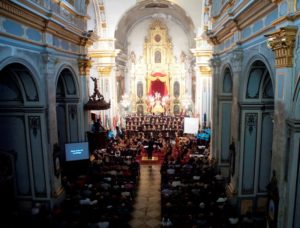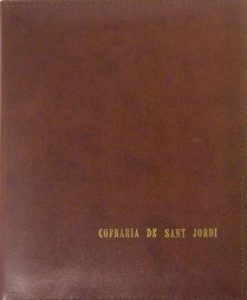Witnessing the solemn procession, at sunset Spring day light, as domineering center of the Moors and Christians celebrated traditionally in the prestigious Bañeres Alicante villa in the days covering the 22 al 25 April each year, I was reminded of the contents of a collection of books, of 600 pages each, with caps parchment and bonds the same skin, that the number of twelve, They contained in the library that had my grandparents and my parents, that they inherited from an ancestor fond of reading pious works.
With the title "Christian Year" or "devotional exercises every day of the year", he wrote, in French, Jesuit Father John Croiset, and they were published in Madrid in MCDCLXIII -1763 -, reigning Carlos 111, translated into Castilian by the famous Padre Island, projecting said literato
Company.
In the month April volume highlights the biographies of San Francisco de Paula, Penitent of Santa Maria Egypciaca, Doctor of the Church Pope St. Leo the Great, San Marcos Evangelista, the glorious San Hermenegildo, son of the Visigoth king Leovigildo and Recaredo brother, San Vicente Ferrer, Valencia glorious Dominican who died in the French city of Vannes having moved the people of various nations with the fire lit their preachings.
“THE GREAT MARTYR”
From our point of view the biography interests us most is the Patron of Bañeres that the author of the book presents itself as one of the “Martyres Church”, which the Greeks called “the great Martyr”, letting us know that he was born in Cappadocia, ancient kingdom of Asia Minor separated from Armenia by the Euphrates, the mightiest rivers of that territory, that at the time of our saint was a Roman province under the power of the Emperor Diocletian.
The future saint enthusiastically embraced the career of arms. References it gives us his biographer make us see that the pattern of Bañeres was one of the military's most famous Roman army of his time.
The images that he forged sculptors and painters from different eras reveal the strength of its full stature, its majestic waisted, his character noble and rid, his keen understanding and living; endowed with a value and a so courteous and gracious manners made him aposentarse in the hearts of his family and friends; and the components of the legions who operated under his command.
A) Yes, until he is driven by his burning love for the true religion, he incurred the wrath of Diocletian Gaius Valerius Aurelius, Roman emperor who lived in the years between 245 a 313 Christian Era, unleashing a fiery anti-Christian, those who fiercely pursued his reign giving proper title of the Era of Martyrs.
The highlight of all was, undoubtedly, the youth of Cappadocia, his condition Maestre Army Field Diocletian, order express this by not obeying his orders, He reduced it to prison, subjecting cruel torment of the main subject you to a wheel was planted with steel spikes whose turns beat him meat that covered blood.
The historian recounts the joy with which the future saint suffered so cruel aberrations, Y, by contrast, momentary healing of such wounds; and the miracles he worked when he was taken to the temple of pagan gods, where, with his words of faith, He overthrew the well carved images of those. Diocletian news of such manifestations of power, fearing that it could contribute to the conversion to Christianity of the Gentiles, the 23 of April 290 Christian Era, he ordered his head cut off so that the handsome young man reached the glory of martyrdom.
Devotion and worship
The memory of the martyr from the day of his death was kept with such devotion that aired continuously from one country to another. Christian congregations of East and West excelled in so pious necessary, It is able to ensure that the cult object that was made to correspond to the amount, importance and notoriety of his miracles.
At the end of the V century, the pious Santa Clotilde erected several temples in various European and Asian cities; and altars, to those who prostrated on his knees informed Christians value, Faith thriving on and Martyr, the glorious miracles wrought by him before and after his martyrdom.
San Germán, Bishop of Paris, one of the most famous European prelates of the sixth century, He contributed mightily to spread the glory of our holy, when, identified with it the return of an operation to East, he built, in honor of San Jorge, a temple that still lingers in the place of the French capital called Saint Germain des Prés.
Many temples and shrines that over time were built in most European and Asian nations in memory of our holy come to show that professed devotion the faithful, the eagerness with which wanted to be his powerful protection.
Knighthood OF SAN JORGE MONTESA AND Alfama
In the year 1470, the Austrian Emperor Frederick IV, I believe, with the name of San Jorge, a military order which had its headquarters in the capital of that powerful nation.
Something similar instituted the Government of the Republic of Genoa, which he attributed to San Jorge obtaining land and sea victories obtained their retinues fighting with neighboring states.
When this happened, the reputation of holiness of the martyr of Cappadocia had come to Spain and in the year 1235, Knights Juan de Almenara and Martin Vidal, in an area of the province of Castellón bordering the Vinaroz, conquered from the Moors, founded a town that King Philip 111, privilege granted by the 8 August 1647, He awarded the title of town ratifying the name already had and today has: Saint George.
In the year 1399 It took place the union of the Order of Montesa with San Jorge de Alfama, founded, is, by King Pedro II of Aragon, son of the monarch Don Jaime the Conqueror, what, in appreciation of the great favors received from our glorious martyr, He determined to institute a military order to the glory of it. Pope Gregarious XI, as distinct from both, ordered on the white habit that should look knights were based in the castle of Montesa, Red Cross will hold the plane corresponding to the glorious San Jorge.
The aforementioned castle was destroyed by an earthquake in the eighteenth century. The most interesting of his paintings was called "Altarpiece of San Jorge», representing our martyr riding on spirited sorrel, acaudillando a large army to fight victoriously to beat the Moors. So valuable work of art, from Fort demolished, you can admire one of the halls of the Museum Victoria in the capital of England, where powerful monarchs took the name of our holy.
In the temple of the castle there was a chapel dedicated to St. George founded by the Master of the Order Bernardo Despuig, to which he gave away two golden chalices with images of St. Mary and our holy, carved on them.
THE BATTLE OF THE PUIG
St. George is the patron of Catalonia and one of its most original ornamenta images the frontispiece of the Palace of the Generalitat.
Barcelonians always imagined the brave doncel, as it is shown in the image venerated in his dressing room of the parish church of Bañeres, that is to say: wearing iron armor, astride a white horse, with a flashing spear, lashing out against the terrible dragon has its plants. Catalonia, like Bañeres, St. George erected by pattern with the desire to revive its purity, the kind of energy necessary for the life of its inhabitants meets the demands of time.
In the city of Valencia San Jorge has a church that bears his name, situated in one of the most progressive districts of the capital.
So valuable parish center I consider it as a testimony of gratitude for the providential help the youth of Cappadocia gave the hosts of King James the Conqueror when campers were at the foot of the castle of El Puig from which carried out the conquest of Valencia.
Aragonese monarch militias were, unexpectedly, surrounded by Moors contingent acaudillaba Zeyan. Engaged in a decisive struggle, bloody (similar to that which took place in Alcoy when San Jorge appeared on the field of battle, influencing Christians who violated a complete defeat to the hosts of AI-Azrach), resulting victorious, also commanded by San Jorge, the prodigious fighter white horse.
A small chapel surrounded by cypress trees, dedicated to the martyr, located at the foot of the hill of El Puig, which it was the scene of the battle, It keeps alive the memory of that miraculous intervention motivating panic and defeat the Saracens.
RELIQUIAS
Go beyond the limits of this paper listing the names of the cities that labeled them one of its streets named Patron of Bañeres; of those that have, also Patrono; of celebrating festivals in their traditional honor; authors of sculptures and paintings representative of his glory and his miracles, They contained in temples and museums; the praise that paid him poets and writers as famous as the writer Joan Maragall CATALAN…
But, before finishing, I feel obliged to mention the antañón sanctuary was built over his grave in the Palestinian population of Lydda, goal of continuous pilgrimages; of his relics, in the eighth century they were transferred, head, in Rome, It is deposited in the church of San Jorge, en Velabro; the right arm to the Cathedral of Ferrara; hands, the French cities of Limoges and Le Mans…
In our country there are several temples where our holy relics are preserved – the San Jorge de Alcoy, in Bañeres, among others -, constitute eloquent testimony of the persevering love that professes martyr of Cappadocia, glorious pattern Bañeres.











